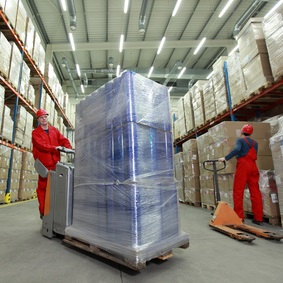Warehouse Safety
 By: Kathleen Murray, Capstone Brokerage Claim Advocate, November 26th, 2018
By: Kathleen Murray, Capstone Brokerage Claim Advocate, November 26th, 2018
Warehouses of any kind are the most dangerous work place. You can easily fall victim to numerous injuries and illnesses. Practicing safe habits and knowing when certain practices are dangerous are crucial in keeping employees and coworkers out of harm’s way. If not properly managed, an unsafe warehouse operation can lead to safety violations and fines from the Occupational Safety & Health Administration (OSHA), which result in severe penalties. The goal of the employer is to provide a safe work place free of injuries and accidents.
The Standard
More than 145,000 people work in over 7,000 warehouses in the United States. The first step to having safe working conditions is to set a minimum safety standard for all practices and operations. Setting clear minimum safety standards reinforces the expectation that safety is always the priority. This could be something as simple as requiring anyone who enters the warehouse environment to use protective eyewear and/or hard hats. For most, these basic safety requirements are dictated by OSHA, and can result in hefty fines if not met. The top ten OSHA standards that are most often cited for non-compliance are:
1. Forklifts
2. Hazard communication
3. Electrical, wiring methods
4. Electrical, system design
5. Guarding floor & wall openings and holes
6. Exits
7. Mechanical power transmission
8. Respiratory protection
9. Lockout/tagout
10. Portable fire extinguishers
Other safety hazards most commonly seen in warehouses include loading/unloading docks, conveyors, and materials storage. By setting basic safety standards for your warehouse, you are actively working towards preventing injury and illness.
The Basics
While all of the above are important safety concerns, it’s always best to start at square one when determining your warehouse’s safety needs. Employees should always be aware of their surroundings and how they function through their day to day activities. They should be given safety training before their work begins and should periodically be reminded of the safe practices they learned upon hiring. Additionally, warehouse supervisors and managers should ensure all safety expectations are posted clearly in close proximity to all equipment. Doing so assures that employees have constant visual reminders of the dangers associated with their job, and the safety precautions they should take to avoid injury. Taking these basic steps are the first part of keeping safety as the priority on the job.
Equipment Safety
Hazards while using warehouse equipment are some of the most prevalent in the warehouse setting, but also some of the most easily preventable. Equipment such as forklifts, hydraulic dollies, hand jacks, etc. should be used with precision and precaution. Below are just a few of the safe practice methods in relation to equipment usage:
Train, evaluate, and certify all operators to ensure they can operate forklifts safely
• Properly maintain haulage equipment including tires
• Before using a forklift, examine it for hazardous conditions which would make it unsafe to operate
• Maintain sufficiently safe clearances for aisles and at loading docks or passages where forklifts are used
• Ensure adequate ventilation either by opened doors/windows or using a ventilation system to provide enough fresh air to keep concentrations of noxious gases from engine exhaust below acceptable limits
• Do not handle loads that are heavier than the weight capacity of the forklift
• Watch out for pedestrians and other vehicles, particularly around aisles
• Use lift trucks with reinforced bumpers
• Make sure any accessories you use for equipment are compatible
• Report, tag, and remove defective equipment from service until repaired
• Always test controls and functionalities before starting a job
The above are just some of the many safety practices recommended for your safety check list to make sure you are using equipment properly in the warehouse setting. There is no such thing as being too careful when working in a warehouse!
Sources:
The Center for Occupational Safety
Occupational Health and Safety Administration
SafetyCulture.com
Categories
- Benefits Resources
- Bonding
- BOP
- Business Insurance
- Commercial Auto
- Commercial Property
- Company News
- Construction
- Crime Insurance
- Cyber Insurance
- Directors & Officers
- Employee Benefits
- Employment Practice Liability Insurance
- Entertainment
- General Liability
- Health Insurance
- Healthcare
- Healthcare Reform
- Homeowners Insurance
- Hospitality
- Manufacturing
- Medical Malpractice
- Mining & Energy
- Nightclubs
- Personal Auto
- Personal Insurance
- Professional
- Restaurants
- Retail & Wholesale
- Risk Management Resources
- Safety Topics
- SBA Bonds
- Security
- Seminars
- Technology
- Tourism
- Transportation
- Uncategorized
- Workers Compensation
Archives
- May 2021
- November 2020
- October 2020
- September 2020
- August 2020
- July 2020
- June 2020
- May 2020
- November 2018
- September 2018
- August 2018
- May 2018
- April 2018
- March 2018
- February 2018
- January 2018
- December 2017
- November 2017
- October 2017
- September 2017
- August 2017
- July 2017
- June 2017
- May 2017
- April 2017
- March 2017
- February 2017
- January 2017
- October 2016
- September 2016
- August 2016
- July 2016
- June 2016
- May 2016
- April 2016
- March 2016
- February 2016
- January 2016
- December 2015
- November 2015
- October 2015
- September 2015
- August 2015
- July 2015
- June 2015
- May 2015
- April 2015
- March 2015
- February 2015
- January 2015
- December 2014
- November 2014
- October 2014
- September 2014
- August 2014
- July 2014
- June 2014
- May 2014
- April 2014
- March 2014
- February 2014
- January 2014
- December 2013
- November 2013
- October 2013
- September 2013
- August 2013
- July 2013
- June 2013
- February 2013
- November 2011
- October 2011
- September 2011
- July 2011
- June 2011
- March 2011
- November 2010
- October 2010
- September 2010
- April 2010
- February 2010
- November 2009
- October 2009
- November 2008
- August 2008


